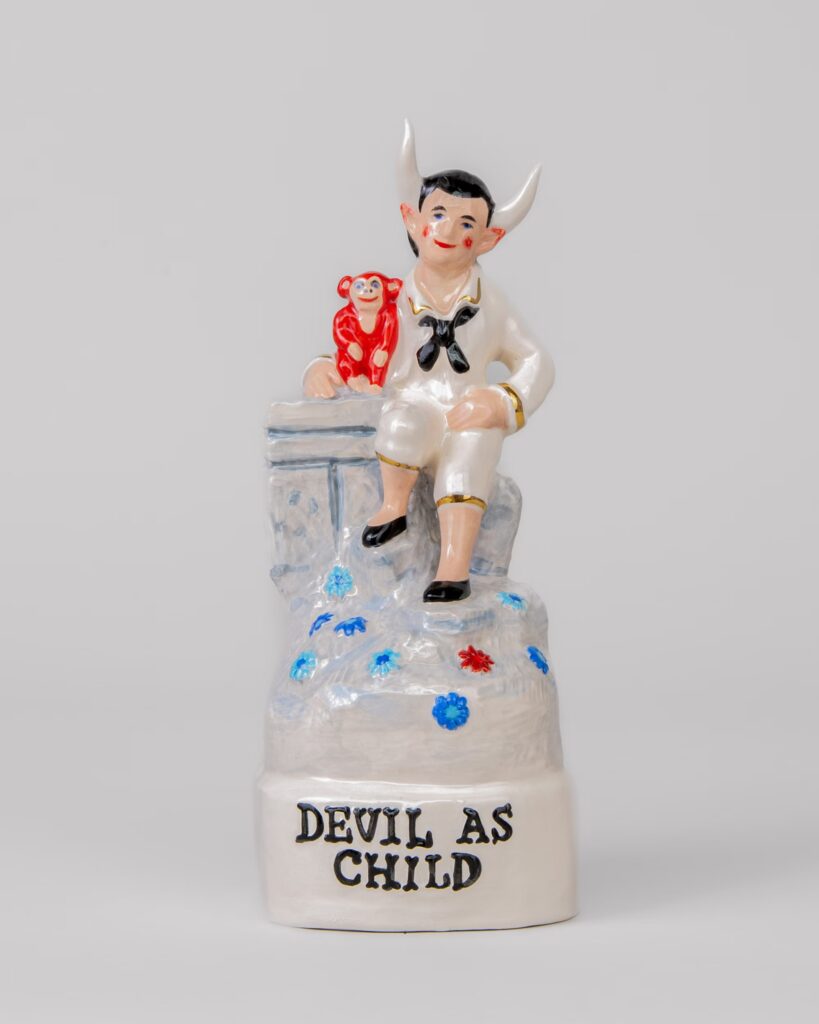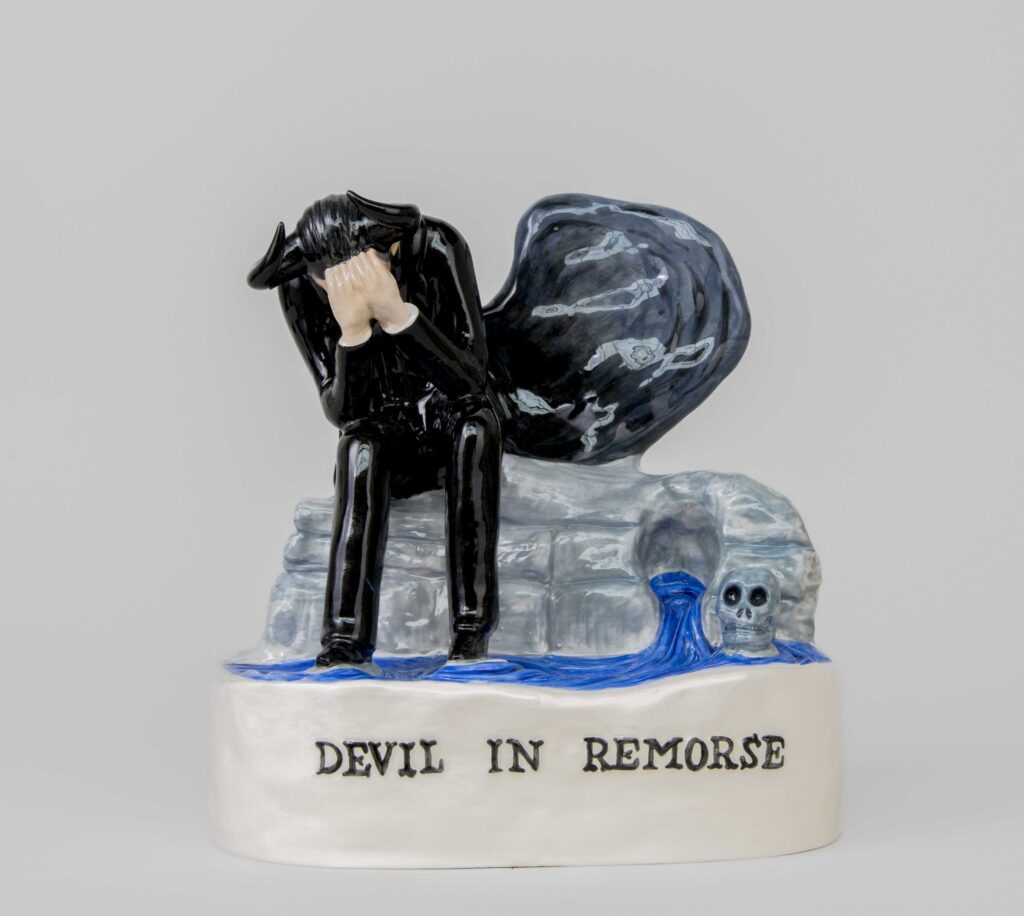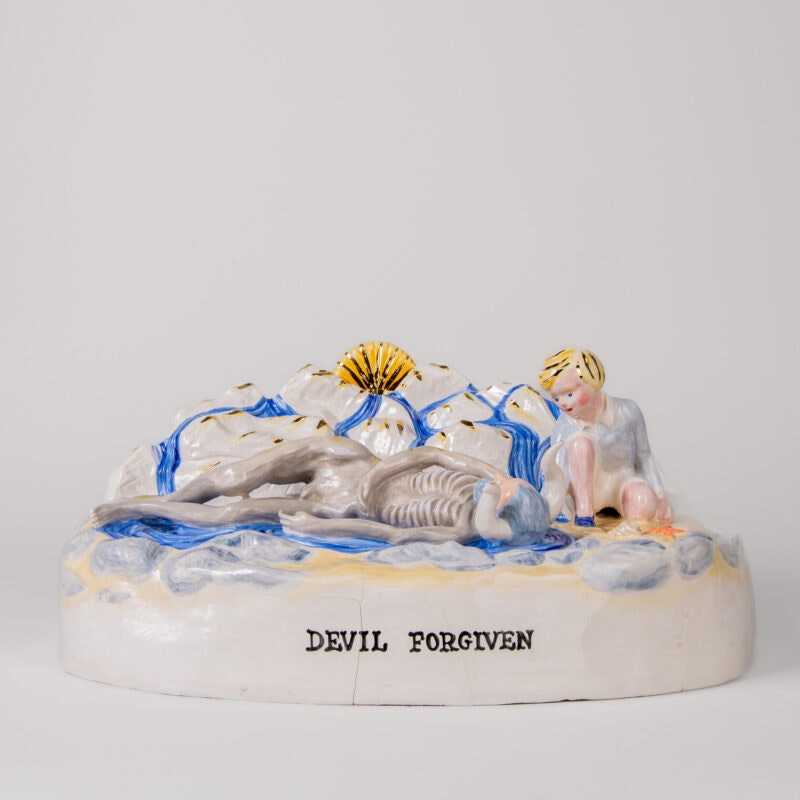Auguste Préault in 10 Romantic Sculptures
People once thought Romanticism belonged only to painting, not sculpture. Auguste Préault challenged that belief with bold creativity. The...
Errika Gerakiti 26 September 2025
Can we feel sympathy for the devil, and can he be forgiven in his remorse? The Devil—A Life is the first major visual work of the famous musician, writer, and poet Nick Cave. In this art project of 17 glazed ceramic figurines, we follow the stations of the Devil’s life and his “humane” struggles with innocence, sin, and grief.
Nick Cave (b. 1957) is an Australian musician and writer, best known as the frontman in Nick Cave and the Bad Seeds, The Birthday Party, and Grinderman. While his music emerged from gothic rock and post-punk, he is a songwriter of many genres, from soft ballads to gospel to blues. Easily recognizable by his low baritone voice, Cave’s music is powerful in poetic songwriting, touching emotional themes of love, religion, violence, and death.
A true man of many talents, the artist continues these themes as a novelist (The Death of Bunny Munro, Stranger Than Kindness, or most recent—Faith, Hope and Carnage) and screenwriter (20,000 Days on Earth). As creative men do, he eventually found an outlet for his talents in visual arts.
Cave signed up for the ceramic studio during a 2020 pandemic pause from touring. It’s not the first time in his life that he worked in pottery—he used to make similar figurines as a child, when attending a clay workshop in the local technical school. During that two week workshop, he made many Staffordshire-style ceramics, which his mother loved so much that she always kept them nearby. As Cave jokingly remarks in one of his interviews, it was the moment she discovered her child might have some talent inside him, except for just trouble.

Installation view of Nick Cave. The Devil—A Life, 2024, Xavier Hufkens gallery, Brussels, Belgium. Photograph by Allard Bovenberg. Courtesy of Xavier Hufkens Brussels.
Fate likes to write her own stories, and Cave’s mother passed the very same morning he was first booked at the ceramic studio. Unable to attend to her funeral, held in a different country, he first thought to cancel the studio reservation. His wife (Susie Cave, model and creative director behind The Vampire’s Wife design studio) wisely advised him to keep it, and go, do what he does best. And what Nick Cave does best, whether in songwriting, poetry, or art, is translating his emotions into stories. The Devil—A Life, marked with grief from the very beginning, is a journey through innate human experiences, lived out by an anthropomorphized Devil.

Nick Cave, Devil Awakens, 2020–2024. Courtesy of Xavier Hufkens Brussels and Museum Voorlinden.
The story of the Devil begins with a shine of red glaze. Cave liked the color, and thought to simply make something with it. After some experiments, he came up with the first figurine, The Devil and the Sailor and soon got the idea to make it a narrative work. Each of the 17 figures represents a seminal stage in the Devil’s life. Worth noting, our protagonist is really just an everyman in disguise, flawed and mortal, born with innocence, yet capable of the worst sins.
The stations of his life are: 1. Devil Awakens, 2. Devil Inherits the World, 3. Devil as a Child, 4. Devil’s First Love, 5. Devil and Sailor, 6. Devil Fights a Lion, 7. Portrait of a Devil, 8. Devil Rides To War, 9. Devil Returns From War, 10. Devil Enters Town in Disguise, 11. Devil Takes a Bride, 12. Devil Kills His First Child, 13. Devil Separated From the World, 14. Devil In Remorse, 15. Devil’s Last Dance, 16. Devil Bleeds To Death, 17. Devil Forgiven.

Installation view of Nick Cave. The Devil—A Life, 2024, Xavier Hufkens gallery, Brussels, Belgium. Photograph by Allard Bovenberg. Courtesy of Xavier Hufkens Brussels.
“I think the Devil gave me a kind of disguise. Even though I didn’t really know it at the time of making them, it was ultimately a way of coming to certain realizations about things happening in my life. So, it was never me, but it was in the end very much so.”
Conversation with Philippe Van Cauteren, Xavier Hufkens Gallery.
Cave’s devil series is full of references. The clearest one is the taken form, inspired directly by Staffordshire figures, popular in Victorian England. Staffordshires are characteristic for their flat back, as they were mainly used to decorate shelves or mantelpieces. They are a popular item in the auctions circle, and Nick Cave himself has a small collection.
The figurines are typically tint-glazed and present a variety of themes—rural idylls, genre scenes from the Bible or literature, groups, equestrian portraits, and many more. Probably the most interesting type, are the ones depicting “sensational” subjects, among them portraits of interesting personalities, stories of war, but also graphic scenes of murders and lion slaying. The Devil’s story fits right in, re-imagining their stylistic elements with a dark, gothic twist.

Nick Cave, Devil as Child, 2020–2024. Courtesy of Xavier Hufkens Brussels and Museum Voorlinden.
In this narrative story, the Devil yields many attributes. As a child, he is accompanied by a red stallion, one of the four horses of the Apocalypse, and later, almost like a plushie, he hugs a monkey—one of the biblical symbols of evil. References to the Bible and religion are clear in the series, adding an extra depth to the narrative story.
The darkest of the figures, number 12—Devil Kills His First Child refers to the parable of Abraham’s sacrifice of Isaac (also a common theme in religious Staffordshire figurines). This grim scene of binding a firstborn brings an emotional cut-off. The evil and the sin, so far just a companion, fully overtake our devilish hero.
In the curatorial interviews surrounding the exhibition at Museum Voorlinden, Cave mentions that at figure 12, he consciously realized the real depth to the series. It’s possible he always carried it with him, understanding it through the cathartic process of sculpting and glazing. With the Devil killing a child, the story comes to a point of devastation—despair, when grief transforms us, forever.
It’s tough to think of the feelings guiding Cave through this process. He has suffered the loss of two of his sons, Arthur in 2015 and Jethro in 2022 . The heartbreaking experience of losing a child can make one wonder about their own role in it and make a parent see themselves as the Devil. Just as the broken, remorseful, crying figure of station 12 wears Cave’s signature black suit.
What started as a desire to create a single small devil figure as a vehicle for an intense red glaze became a journey towards some kind of absolution from a series of shattering events.
Artist Talk with Margriet van der Linden, 2024, Museum Voorlinden.

In the last three stations, the Devil completes his last dance on this planet, ending his human adventure by bleeding to death. In station 17, Devil Forgiven, his body is perished to gray bones, washed up on the beach. Yet, his face still carries a pinkish color. Perhaps it’s a color of life and joy he feels as he looks at a child crouched by his side. He is welcomed with forgiveness.

Nick Cave, Devil Forgiven, 2020–2024. Courtesy of Xavier Hufkens Brussels.
(…) Who sat down on the narrow bed, this flaming boy
Said, we’ve all had too much sorrow, now is the time for joy.
Nick Cave’s Devil—A Life was exhibited in 2024 at the Sara Hilden Art Museum in Finland, the Xavier Hufkens Gallery in Brussels, and, most recently, the Museum Voorlinden and Gardens in the Netherlands. If you want to discover the Devil’s story yourself; the Voorlinden exhibition was complimented with many artist talks, as well as an additional poetic extension written by Cave for the Voorlinden catalogue.
DailyArt Magazine needs your support. Every contribution, however big or small, is very valuable for our future. Thanks to it, we will be able to sustain and grow the Magazine. Thank you for your help!